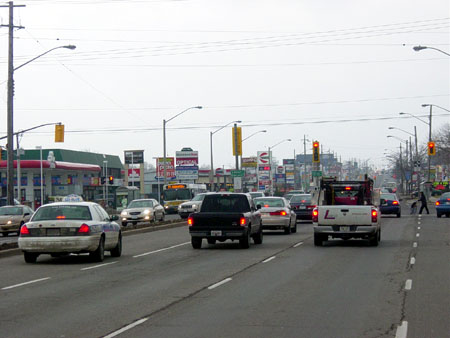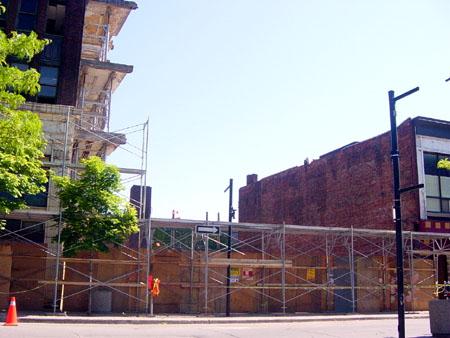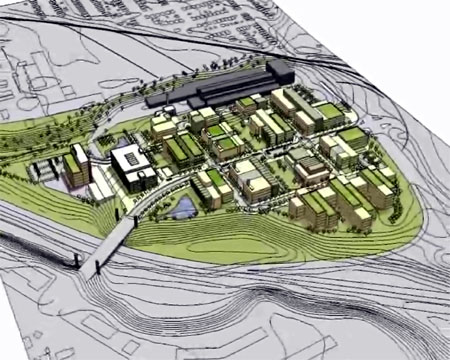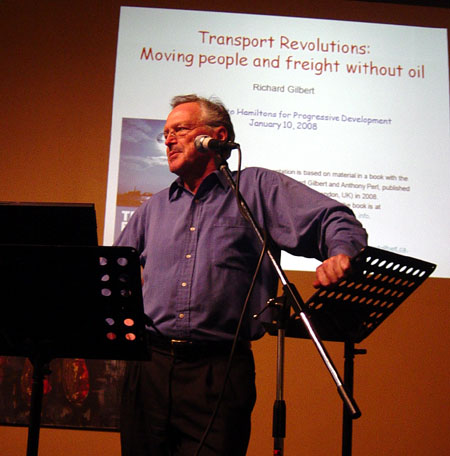The opportunities that have the best long-term prospects are not warehouses in the middle of nowhere, but a dense, healthy downtown that mixes uses, welcomes artists, leverages the university and college, and brings creative people together to solve probl
By Ryan McGreal
Published May 19, 2009
For all our ingenuity, humans have yet to invent an idea machine. Creativity remains an ad hoc, serendipitous process. Yet if some brilliant meta-inventor were to achieve such an ambitious goal, the result might well resemble a city.
Cities do not generate ideas in themselves, but they do bring creative people into contact: cross-fertilizing ideas from one intellectual domain to another; asking open-ended questions; challenging orthodoxy; forking a project into separate groups that progress independently; and merging forked developments to integrate their best features.
Creativity leads to invention - producing something new. Invention leads to innovation - putting the invention into practice. Innovations that generate value survive and reproduce, feeding the next wave of invention.
In a broader sense, societies that foster the chain of creativity-invention-innovation produce better tools for growing and responding to challenges. At its most impressive, innovation transforms crisis into opportunity.
Best known for her 1961 book, The Death and Life of Great American Cities, the renowned urbanist Jane Jacobs continued to develop her ideas over the next four decades until her death in 2006. In her 1994 book The Nature of Economies, Jacobs theorizes, "Natural processes rule human economic life."
She argues that economies grow through bifurcations - branching and differentiation that emerges from generality and becomes a new generality from which more differentiations can emerge. She highlights the role of positive and negative feedback loops plus "emergency adaptations" to produce a dynamic equilibrium in self-regulating systems.
Just as biological systems capture and use energy, so do economic systems. Like biological systems, density and diversity are critical: "The more different means a system possesses for recapturing, using, and passing around energy before its discharge from the system, the larger are the cumulative consequences of the energy it receives."
Jacobs' works teem with insight into the crucial roles played by self-organized networks that innovate by discovering uses for otherwise wasted resources.
For innovation to happen, creative people need to cross paths regularly so they can rub off on each other. Combined with the opportunities for innovators, investors and entrepreneurs to join forces, this suggests that place remains significant.
So argues Richard Florida in his new book Who's Your City? Florida, a business and creativity professor at the University of Toronto, gained popularity with The Rise of the Creative Class in 2002, in which he first drew popular attention to creative professionals - artists, designers, engineers, entrepreneurs, innovators, inventors, investors, musicians, scientists - and the wealth they generate.
In Who's Your City?, Florida shifts focus from the people who drive economic growth to the urban environments that attract and facilitate such people. Florida insists that place is more important than ever. The most creative mega-regions (large, contiguous urban areas often spanning more than one municipality) are diverging ever more rapidly in their rates of growth, producing a "spiky" world.
He argues that most robust mega-regions don't merely specialize, but also innovate by growing ecosystems of investors, entrepreneurs and innovators that attract and retain creative people. Mega-regions thereby generate both economies of scale and network effects in great positive feedback loops.

Suburban arterial roads lined with strip malls and big box stores won't drive an innovative economy (RTH file photo)
Strong evidence suggests that increasing population density and mixing destinations more closely confers measurable economies. When cities intensify, energy and infrastructure costs grow more slowly than population, but the innovation rate grows more quickly than population.
Scale up a city and you get both an infrastructure productivity boost and a boost in the rate of creative output.
Scale up a city and you get both an infrastructure productivity boost and a boost in the rate of creative output. Quoting economist Robert Lucas, Florida calls this the "clustering force" and it explains why modern telecommunications have not made place irrelevant.
Florida writes, "Creative people and companies cluster because of the powerful productivity advantages, economies of scale, and knowledge spillovers such density brings."
Jacobs moved to Toronto to keep her draft-age sons out of the Vietnam War, and subsequently influenced the city's culture. It was this same culture that attracted Florida, though he came to seize opportunity rather than escape danger.
Both pay close attention to how people actually live and interact, though Jacobs studied individuals on the street and Florida favours statistical analysis. They agree that the real action lies in urban rather than political boundaries, evidenced by Florida's border-straddling "Tor-Buff-Chester" mega-region, which encompasses Montreal, Ottawa, Toronto, Hamilton, Buffalo and Rochester.
Jacobs emphasized diversification whereas Florida emphasizes specialization. She disdained public enterprises, dismissing top-heavy megaprojects (like the Spadina Expressway, which she famously helped to cancel) as lumbering intrusions into organic processes. Florida, by contrast, sees an essential role for governments to nurture creative incubators.
Florida spoke at Hamilton's first economic summit last May. Telling the attendees that they "can't help but be part of a boom," he encouraged Hamilton's leaders to see the city as part of the Tor-Buff-Chester mega-region, not as an economic island. He recommended investing in what he calls the Three Ts: technology (universities, research centres), attracting and retaining talent (especially recent graduates), and fostering tolerance for people with diverse values, ideas and lifestyles.

Missing tooth: scaffolding blocks access to the demolished lot of the Balfour Building on King William next to the Lister Building. Richard Florida warned Hamilton not to demolish its heritage buildings. (RTH file photo)
He further admonished his audience to preserve Hamilton's wealth of old buildings and to resist the negativity and defeatism of "squelchers".
So how does Hamilton's creative economy measure up?
The Hamilton Creative City Initiative (HCCI) is one attempt at an answer. A joint effort by the Imperial Cotton Centre for the Arts, Centre for Community Study and Community Centre for Media Arts, HCCI defines creative work more narrowly than Florida, focusing mainly on visual and performing arts, broadcasting, film, music, publishing and graphic design - 3.4 percent of Hamilton's labour force.
Phase 1 surveyed creative organizations to sketch Hamilton's creative landscape. (Phase 2 will study creative individuals.) Hamilton's creative sector largely comprises small- and medium-sized businesses with few employees and modest profits. Those businesses enjoy many interlocks, sharing resources, collaborating on projects, using community spaces, and clustering geographically in the downtown core, Southwest Hamilton, and Dundas.
The report concludes that the creative industry "should be viewed as [an economic] cluster that has potential for growth and greater success" and recommends a more active role for the city in supporting, promoting and marketing this cluster.
One such business is factor[e] design initiative, a multimedia studio. Factor[e] has occupied all three of Hamilton's creative clusters: it started in Dundas in 1999, moved to James St. South, and is now on Locke St.
Factor[e] president Tyler Cowie says he worked mainly with foreign clients at first because "potential clients [in Hamilton] did not see the value in investing in professional graphics". This has changed: in the past four years, business has shifted from the US and Europe to more local clients, due to what he calls "a shift in perception of the cost/quality of design".
Another issue has been the search for qualified employees. "Good designers and professionals seem to seek work in Toronto or in the US." Demonstrating the tight networking of Hamilton's creative industry, he has "more luck finding skilled individuals by word of mouth rather than through the classifieds or other traditional methods."
Factor[e] is a Hamilton success story, but many creative professionals seek opportunity elsewhere. Simon Woodside is the president and creator of Semacode, which makes software that lets cell phones read website URLs by scanning barcodes.
Woodside lives in Hamilton but works from the Accelerator Centre, a Waterloo research facility started by the University of Waterloo, the city, province and federal government. He explains, "The key resources for a startup company are there... You have a talent base. It's very easy to find and hire very talented software developers and engineers in Waterloo because of the university."
Echoing Florida's emphasis on attracting and retaining talent, Woodside adds, "Many of the co-op students [and graduates] like to work in town, even if there are more prestigious jobs available in other parts of the world."
Woodside believes Hamilton lacks "the talent base to support a software company, let alone knowledgeable business people to network with, service providers, and investors." Waterloo enjoys a "positive reinforcement effect" starting with early spinoff firms, like Watcom in 1981 and Research In Motion in 1984. "If you look at the history of Silicon Valley you see a similar pattern, except starting a bit earlier. The same with MIT in Cambridge."
Despite a university, college, diverse population, extant industry, booming health sciences and viable urban form, Hamilton has yet to put the pieces together. We're not investing in technology, attracting creative professionals, or doing enough to promote a culture of tolerance for new ideas.
One attempt to connect the pieces is McMaster Innovation Park (MIP), a planned research centre in southwest Hamilton specializing in advanced manufacturing and materials, nanotechnology and biotechnology. Created with McMaster University and all three government levels, MIP is designed on the principle of connections.

McMaster Innovation Park site plan (Image Credit: McMaster Innovation Park Site Fly Through)
Supporters hope it will transform an abandoned industrial site into an incubator for spinoff business start-ups combining researchers, entrepreneurs, and venture capitalists. The site plan emphasizes "an urban neighbourhood to facilitate interaction, creativity and innovation," mixed uses, open space for chance meetings, ecological building design and sustainable transportation.
It's an exciting initiative, but it is the exception in Hamilton planning, not the rule. The city's planning and economic development department have pinned their hopes not on MIP or other brownfield initiatives but on the Airport Employment Growth District (AEGD), 1,134 hectares of prime farmland around Hamilton International Airport in Mount Hope.
Since 2005's Growth-Related Integrated Development Strategy (GRIDS), the airport plan has served as the non-negotiable core of Hamilton's economic development strategy. It was included in all six GRIDS proposals even though it violates seven of the nine Grids Directions, which support a firm urban boundary, intensification, compatible mixed uses, and maximizing existing infrastructure.

AEGD Study Area (Image Credit: Hamilton Airport Employment Growth District Land Use Report, City of Hamilton, May 2008)
It originated as "aerotropolis" after an economic model by John Kasarda, an economics professor at the University of North Carolina-Chapel Hill. According to Kasarda, eighteenth century cities grew around shipping ports, nineteenth century cities grew around rail nodes, and twentieth century cities grew around highways. Twenty-first century cities will grow around airports, as people demand the speed, flexibility, and convenience that only air transport can provide.
In the aerotropolis economy, the three As ("accessibility, accessibility, accessibility") replace the three Ls ("location, location, location"), as high-tech companies leverage proximity to the airport.
It sounds impressive, and Kasarda's description is nuanced - a dense, diverse, well-planned, and even aesthetically pleasing mix of complementary facilities and amenities. However, the city's plan doesn't appear to do this. Instead, we get a collection of large, low-density, single-use lots used mainly for warehousing and logistics (two-thirds of the total land) with some high-tech manufacturing, punctuated by the odd strip plaza.
The price tag will be huge: hundred million dollar servicing charges, the loss of prime farmland, and a dramatic shift in the city's centre of gravity, not to mention the opportunity cost. Worse, the plan's architects seem determined to see the project to completion whether or not it actually makes sense.
After council voted in June 2005 to expand the urban boundary (despite 21 out of 28 delegations opposing the move), two groups appealed to the Ontario Municipal Board: a citizens' group called Hamiltonians for Progressive Development and the Ontario Ministry of Municipal Affairs and Housing (MMAH). A September 2006 settlement required the city to conduct land use studies and public consultation through a community liaison committee before expanding the urban boundary.
Hemson Consulting presented a "comprehensive employment land study" to council in February 2007. It offered just one option: logistics and warehousing around the airport. It narrowly defined employment lands as "what occurs in business parks" and dismissed brownfield redevelopment altogether. It also neglected to project energy prices over the next 25 years, assuming they would remain at then-current rates.

Hwy 403 winds up the Escarpment toward Ancaster (RTH file photo)
Council ordered staff to prepare a supplemental report on brownfield employment opportunities. That report, also prepared by Hemson, largely redefined the city's 1,386 brownfield properties out of existence, concluding that less than 75 acres are available.
The community liaison committee was stacked with airport supporters, including representatives from the airport, Chamber of Commerce, realtors association, a commercial property developer and the Agricultural and Rural Affairs Committee, a housing developer, a real estate agent, the former Glanbrook town planner, and an air traffic controller.
Meanwhile, MMAH has challenged several assumptions used to calculate the total land required. Based on the MMAH figures, the total size should be much smaller. City staff knew about this for several months, but Council didn't see the ministry's letter until the day of the meeting to approve phase 1 of the study.
A motion to halve the employment area was defeated, though the city later backed down on some of its assumptions about the recommended size of the study area.
Creativity turns crisis into opportunity by identifying challenges and inventing new ways to solve them. This needs good feedback mechanisms to work properly, but our feedback system has broken down, at least with respect to the city's airport development plans.
The most glaring issue is the fact that energy prices rose steadily for a decade before collapsing last summer in the wake of a global economic crisis. Most analysts believe oil prices will spike again once the economy recovers. The global rate of oil production is at or near an all-time peak and will soon begin a permanent decline. This is "peak oil", and it is finally starting to enter the mainstream.
Yet the city refuses to take into account what role energy price volatility will play in airport-related development, even though a city report completed in early 2006 examines precisely this issue: Richard Gilbert's study Hamilton: The Electric City [PDF link].
In June 2005, as a response to growing public concerns about energy security, Hamilton City Council instructed planning staff to "prepare an analysis to establish a strategy to deal with the potential fossil fuel crisis" and assess the potential impacts on Hamilton's long-term economic plans. Staff contracted with Gilbert to prepare the report.
A former Toronto councillor and president of the Federation of Canadian Municipalities, Gilbert has worked since the 1990s as an urban planning and energy policy consultant, including work for the International Energy Agency. With Anthony Perl, he just co-authored Transport Revolutions: Moving people and freight without oil.
We met in June 2005 to discuss his criteria for whether rising energy prices will impact Hamilton's development plans. Within the planning horizon (25 years), gasoline and natural gas (NG) prices would have to quadruple to force substantial changes in land use and transportation.
If the likelihood of this were less than 25 percent, he would not recommend any change from the status quo. If the likelihood exceeded 25 percent but not 50 percent, he would recommend keeping energy focus as a "Plan B". Above 50 percent, he would recommend putting energy front and centre.

Richard Gilbert explains how cities must respond to rising and volatile energy prices in a January 8, 2008 lecture in Hamilton (RTH file photo)
At the time, Gilbert doubted the latter scenario, telling me, "I think the advocates who pushed for this study are going to be disappointed with my conclusions." He expected to find less than 50 percent chance of gas and NG prices quadrupling.
Two months and much research later, Gilbert turned the tables with the first draft of his report, which concluded that energy prices were more than fifty percent likely to quadruple by 2018, only 13 years hence. An August 22, 2005 Hamilton Spectator article quoted him saying, "Air travel in the ways we understand it is doomed."
City staff requested more changes, and Gilbert finally presented to Council in April 2006, when oil was trading at $55/barrel. Council asked staff to prepare follow-up studies on Hamilton's vulnerability to peak oil. More than two years later, those studies are still pending.
At the time, several councillors tried to press Gilbert to acknowledge the value of the airport lands as a place to develop his vision of an energy sector. Gilbert carefully demurred, suggesting that it was outside the scope of his study to tell the city where to build, but he did state the following:
My own opinion, but this is not an opinion based on expert research, is that you have a huge opportunity for developing lands for this kind of purpose between where we're sitting now [City Hall, 71 Main St. W. at Bay St.] and the harbour. I've walked around there, and around the harbour, and I'm just impressed by the opportunities for the kinds of industrial development that I'm talking about, which is very knowledge-intensive, very rich in small-scale activity.
He also suggested that in Hamilton, the tendency is for "putting the land first and then wondering how to fill the land with jobs. What I'm proposing is an alternative way of going about it, which is figuring out what you want to do and then after you've defined it a bit, what the lands are."
As it is, Hamilton already has plenty of highway-accessible greenfield employment lands, but they too often end up rezoned for yet more residential development while we wait for some corporate white knight to relocate here.
Meanwhile, John Kasarda still believes aerotropolis has good long-term prospects. When I asked him about the effects of rising oil prices, he responded that aviation "is a structural process with its forecasted growth not likely reversed in the longer-term through even higher oil prices than present."
He notes that the industry survived the oil crises of the 1970s. Yet those crises were political in origin, and today's crisis is geological: half the oil is gone, the easy-to-reach half.
If last summer's prices were merely speculative, we should have seen inventories build up, but even though North American motoring actually declined last year for the first time in decades, supply could still barely match demand. It was not until demand collapsed well below its pre-recession peak that prices fell in turn.
Even now, oil futures are trading at or near $60 per barrel. This may seem cheap compared to the super-spike a year ago, but recall that in 1999, during a long economic growth period, oil prices were trading in the $15-20 per barrel range. Today's prices are more than triple the previously-assumed baseline price, despite a deep, sharp global recession.Gilbert saw the looming crisis as an opportunity for Hamilton to grow its economy around energy conservation and production: retrofitting buildings, expanding wind, solar and micro-hydro power, transforming our transportation system to run on electricity, and revitalizing our underused built environment.
A citywide commitment and a little imagination could make Hamilton an energy leader, building expertise and attracting the most talented engineers, innovators, investors and entrepreneurs in a positive feedback loop of growth - even as we insulate our own economy from energy price volatility.
Instead, status quo thinking paralyzes us. AEGD supporters insist that businesses around the airport need not be airport-related - but if not, there's no particular reason they have to be around the airport.
Hamilton already has greenfield business parks with highway access that sit empty until residential or big box commercial developers buy them out. Even the employment lands next to McMaster Innovation Park have been under threat from a big box developer.)
There are some positive signs: planned light rail lines running from McMaster to Eastgate Square and from the waterfront to Upper James; a restored Lister Block; and a steady trickle of new downtown developments, among other highlights.
These opportunities have the best long-term prospects: not warehouses in the middle of nowhere, but a dense, healthy downtown that mixes uses, welcomes artists, leverages the university and college, and brings creative people together to solve problems and create lasting value.
By z jones (registered) | Posted May 19, 2009 at 11:59:21
tl;dr.
LOL. Just kidding, but a LOT to digest in here. Tell me again why you weren't at last months Economic Summit?
By nobrainer (registered) | Posted May 19, 2009 at 12:03:35
Combine this with David Van Beveren's essay on citizens taking matters into their own hands, and it sounds like this is a recipe for a citizens economic summit and a new popular movement. Expecting our leaders to do the right thing hasn't been working out so well.
By zookeeper (registered) | Posted May 19, 2009 at 14:52:38
Please, make the hurting stop. When I think of the blown opportunities in this city it breaks my heart. Interesting contrast between new urbanist prophets Jacobs and Florida, it's as if Jacobs had no examples handy of governments actually fomenting economic development so assumed anything they touch would turn to crap. Florida meanwhile has Silicon Valley as a case study in how to do it (more or less) right. Question is, are Hamilton's pols more like the visionaries Florida believes we can get or are they more like the knuckle-draggers Jacobs spent her life fighting?
By Wow (anonymous) | Posted May 19, 2009 at 15:03:29
All I have to say is that this City's NEXT generation of leaders will be the ones to FINALLY turn this City around... lets all just hope it wont be too late!
Great peice, Ryan. Definately makes one think!
By gullchasedship (registered) - website | Posted May 19, 2009 at 18:17:23
I just wanted to point out that the oil crisis in the seventies was geographical in that the US had passed its peak and was increasingly reliant upon foreign oil.
By jason (registered) | Posted May 19, 2009 at 19:01:27
this is a brilliant article. A dream of mine is to read an article like this someday with an author name like "Neil Everson" or "John Dolbec" at the end of it.
More bullsh!t. Cut tax rates to 0.5% and allow individuals and businesses to spend their money they way they see fit.
Can't lower taxes without first curbing the biggest cost to taxpayers: unnecessary sprawl! Can't stop sprawl without regulation because we all know that the LAST thing corporate developers have in mind is the well-being of taxpayers. If they did, they'd develop land that didn't cost taxpayers an arm and a leg to maintain.
Wow...can't have the capitalists dream of lower taxes without regulation? Its like the Twilight Zone!!!
By A Smith (anonymous) | Posted May 19, 2009 at 22:09:07
C.Erl >> Can't lower taxes without first curbing the biggest cost to taxpayers: unnecessary sprawl
You may be correct. If this is the case, then Hamilton will see development take place within existing urban areas, which would do wonders for the downtown.
>> can't have the capitalists dream of lower taxes without regulation?
Regulation on government spending sounds like a great idea.
By z jones (registered) | Posted May 19, 2009 at 22:24:53
^ Poor old Smitty, he's hitched his wagon to a simplistic correlation between tax rates and economic prosperity. It must be so embarrassing to him that there are no rich countries with really low tax rates and that rich countries with lower tax rates have more poverty.
By zookeeper (registered) | Posted May 19, 2009 at 23:07:54
^Don't engage the troll. Just downvote and move along.
By dumbleclark (anonymous) | Posted May 20, 2009 at 09:07:08
Smitty's got some issues.
If you actually read the HCCI report there sMitty you'll see that more than half of the companies surveyed are entrepreneurs and not charities and non-profits. They are 'capitalist' businesses as you would suggest.
That fact that they require investment from the government is nothing new - almost every single industry in our country receives government investment. Farmers, oil drillers, now car manufacturers, steel companies, radio broadcasters, you name it.
What the report suggests is that the creative industries have actually been undervalued, and under serviced in Canada for decades. It also suggests that investment does not have to come in the form of cold hard cash - a relatively small percentage of the participants even noted receiving subsidies - but more so in marketing assistance, cluster support like others in Hamilton, and through effective infrastructure (like the numerous incubation centre for other industires, and those which are hugely successful and profit generating for other cities).
Unfortunately forward thinking creative people run up against your kind of archaic thinking everyday. We'll get it over it, just like I've gotten over you.
By blah, blah, blah (anonymous) | Posted May 20, 2009 at 16:22:40
A Smith: You are pretty bold in spewing your rhetoric against those who work in a creative industry and run their own businesses.
I mean if you are going to spew at least tell the readers here, just exactly is your business experience, so at least people can understand your venom.
Anyways, if you bothered to read to the HCCI report, you would see that a great nubmer of volunteers help to make live better in this city.
You want to talk about value, just exactly what value do you offer to the community as a whole?
By A Smith (anonymous) | Posted May 20, 2009 at 19:58:31
Blah, to have a good economy, you need to reward success and penalize failure. When the government gives money to people who can't turn a profit, this rewards failure and penalizes success. And then we wonder why Hamilton is not filled with innovative businesses that create wealth for society and good wages for residents. Is this so hard to understand?
By blah, blah, blah (anonymous) | Posted May 20, 2009 at 20:32:01
A Smith: You did not answer the quesions, why not?
By jason (registered) | Posted May 20, 2009 at 22:46:01
yea, this new voting system is doing a great job cleaning up the conversations. Same old crap.
By reuben (registered) - website | Posted May 20, 2009 at 23:23:08
so far, i think the right posts are getting the right votes, dont you jason?
the second stage of implementation will allow you to filter the votes. from my understanding, we are still in a 'test phase'
Mr. Smith, you are making us think and are helping us fine tune our arguments so that they can withstand even the strongest attacks, so thank you for that.
That aside, I wanted to take a shot at your question.
In short: It doesn't. Yet, no one was advocating any sort of redistributive measures in the article posted. What has been advocated is investments that would attract both businesses and more creative individuals (who, as studies have proven, also attract new businesses) to this city. By redefining municipal restrictions and placing regulations on what is necessary (sprawl that is costly to taxpayers, living 'nodes' that are costly to maintain and force the city to raise taxes, etc) we can draw more businesses in and, therefore, revitalize the city.
What can't be justified is taking money away from successful businesses to spend on absolutely unnecessary suburban projects, built at the whim of a developer who does not have the interests of the greater Hamiltonian business community in mind. We can't penalize businesses for the mistakes of other businesses, in this case, developers.
To keep taxes low, we have to set and stick to urban boundaries. To attract investment, we have to spend on infrastructure.
I hope that answers your question!
By nobrainer (registered) | Posted May 21, 2009 at 10:36:51
^So are you suggesting that Hamilton should try to be another 'Silicon Valley North'?
By JonC (registered) | Posted May 21, 2009 at 11:14:54
Focusing on competing against K-W's established facilities wouldn't be the best of ideas. A more practical idea would be to focus on another area (or two). The obvious choice at this point in time is green engineering & science. We also have an established foothold in medicine already, so perhaps encouraging growth in side areas of that field would be a practical area to encourage growth.
By UrbanRenaissance (registered) | Posted May 21, 2009 at 12:04:20
Biotech/medicine seems like a logical choice given Mac's emphasis seems to be weighted more towards medicine and engineering. Material sciences too since we already have the CANMET facility coming and Mac's close ties with the local steel companies.
Green tech also seems like a good idea. I seem to recall an article I read a couple years ago where a company who builds offshore wind turbines wanted to build a few in the Great Lakes. Specifically Lakes Erie and Ontario where you get fairly consistent winds but with shallower water depths. And as anyone who drives regularly over the Skyway can tell you we definitely get some good winds in this area.
The aerospace industry could also work since we have an international airport close by. Mississauga is already well established in this area but its an expensive city and new start ups might find cheaper office space here.
There really are a lot of options.
By highwater (registered) | Posted May 21, 2009 at 13:41:53
Ryan wrote: >but I can imagine some kind of creative hub around, say, Gore Park (think of all the upstairs office space that would overlook the park's tree canopy).
I would prefer to see it in an industrial area. Industrial spaces can be divided up for offices and studios, but would also allow space and truck access for larger scale fabrication.
By jason (registered) | Posted May 21, 2009 at 23:07:44
turning into a gameshow???
We passed that point about 6 months ago.
By JonC (registered) | Posted May 21, 2009 at 23:08:20
You don't want to engage in honest debate, so why bother?
By nobrainer (registered) | Posted May 22, 2009 at 00:05:54
^sigh, the myth of the freewheeling inventor. Also, poor baby, crying because it's getting easier to ignore your trolls. This will officially be my last reply to you, from now on I'm taking zookeeper's advice to down vote and move on.
By jason (registered) | Posted May 22, 2009 at 07:31:21
ASmith said - "In order to sell that story, you need to tell everyone to stop voting for me AND stop responding."
Ok, you've convinced me.
By JonC (registered) | Posted May 22, 2009 at 08:46:12
Hopefully the implementation of phase two of moderation will clarify that the voting is to assist other people from having to read pointless garbage, like say countering claims of intellectual dishonest by using intellectual dishonesty (hint for A Smith: Ryan never said that). Classy.
By z jones (registered) | Posted May 22, 2009 at 13:31:40
Smitty do you agree with Ryan's statement "The Wright brothers invented a plane, but it was a combination of entrepreneurial activity, universal education, publicly funded R&D and so on that turned a proof of concept into the aerospace industry"? Or do you think it was only the first and the rest don't matter? Why was the airplane invented in one of the first countries to have universal education? C'mon, I know you love simple correlations, why isn't this one good enough for you?
"If a business incubator will produce profits for people in Hamilton, let them risk their own money and reap the rewards if they're successful. Good ideas can attract billions in private funds, so there is no reason why government needs to take on this role." So how come there aren't any IT hubs that weren't first supported by university research spinoffs and public investment?
You're praising the trees for growing so tall while ignoring the rich soil that nourishes them.
By zookeeper (registered) | Posted May 22, 2009 at 13:44:52
Downvote and move on folks, just downvote and move on. Feeding the trolls just encourages them to keep coming back for more.
By Brandon (registered) | Posted May 22, 2009 at 16:29:49
Too funny. Using Walmart as an example of why society gets richer.
I guess it depends on your definition of "Society".
By Frank (registered) | Posted May 25, 2009 at 08:37:50
Back to the original question about becoming a centre of innovation:
I agree with several other posters on here. We are in a great position to become a hub for environmental and medical innovation. As an engineering technologist, I've talked with other engineering technologists and our focus (at least in the younger crowd) is pushed towards the environmental side of things. We have Mac which is recognized globally as a place to go to study medicine, we have a harbour which allows us to ship innovations worldwide, we have a decent economy where people who aren't necessarily the richest can still thrive etc, but we have to look up and out, not down and back.
Living in the past, building like we used to, sticking to the status quo will absolutely NOT enable us to be Innovation Central, it will keep us the way we are now.
By Brandon (registered) | Posted May 26, 2009 at 08:50:57
More wasteful government spending:
By z jones (registered) | Posted May 26, 2009 at 19:23:44
@Ryan thanks for the props. Buffet has enough "f* you" money that he gets to say what's really on his mind. LOL.
You must be logged in to comment.
There are no upcoming events right now.
Why not post one?